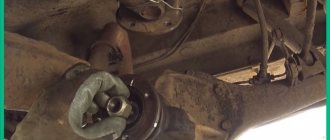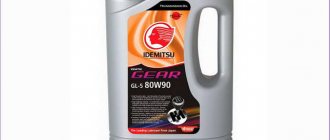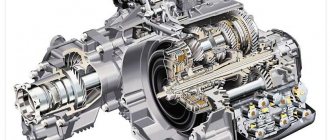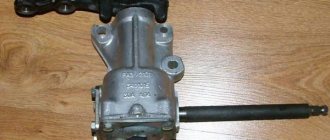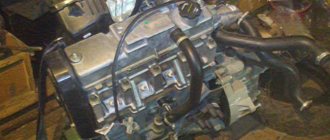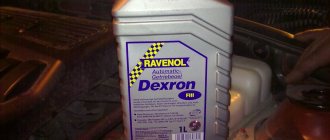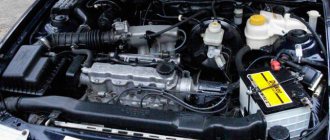Changing the oil in the steering gear
Good day, dear friends.
As many owners of classic VAZs know, we have an “amazing” steering gear mechanism. But many people forget, and undeservedly, that it at least needs to change the oil once every one and a half to two years. While I’m slowly servicing the car since the purchase, I decided to change the (as it turned out still factory) TAD-17 with a Kixx Geartec 75w85, so that it spins better in winter (regular transmission oil is poured into the steering gear), and at the same time adjust the steering play. First, remove the black protective cap, then use a size 8 wrench to unscrew the filler hole.
Since the gearbox does not have a drain hole, we take a tube from the dropper and a syringe, and pump out the oil from there, poking the tube inside everywhere to pump out as much as possible.
The blackening oil was sucked out, I filled it with new, amber oil))) According to the manual, the fill is ≈0.2 liters, personally, I filled it to the fullest. In fact, I didn’t calculate the volume, but it won’t be any worse. I unscrewed the adjusting nut and used a screwdriver to adjust the required tension of the steering wheel, turning the screw left/right, achieving optimal lightness and tension.
As a result, the steering wheel became a little easier to turn, the play was reduced, and my soul became calmer))) Beaver to everyone and take care of your loved ones)))
Source
What oil to fill in power steering: review of popular formulations
There are several rules that govern the use of hydraulic oils in modern power steering systems:
- It is necessary to strictly follow the car manufacturer's instructions specified in the service book. Sometimes the type of fluid required for the system is duplicated on the cap of the power steering expansion tank. It is better to ignore advice from forums or from “garage mechanics” - such sources can only misinform you.
- It is better not to mix different liquids. If necessary, you need to at least make sure that the type of base matches and read the instructions on the package. Usually the manufacturer indicates on the packaging a short list of compatible oils.
- In the event of a leak, it is better to fill in the wrong oil as a temporary measure than to drive with dry power steering. An unsuitable working fluid will not have time to seriously damage the rack seals in a short time, and driving with a dry system in just a few kilometers can render the pump and rack unusable.
So which oil is better for the power steering of a modern car? There is no definite answer to this question; it all depends on your specific car. Let's take a quick look at several popular power steering fluids today:
- Lukoil ATF Synth Multi Dextron III. Universal liquid at a low price. Suitable for both automatic transmission and power steering, it has many positive reviews from car owners in terms of use in both power steering and power steering.
- StatOil Pentosin LHM Plus. High-quality fluid developed specifically for power steering of Citroen cars. Resistant to temperature changes, it has proven itself when working in Russian winter conditions.
- Hyundai 80W NEF. Time-tested liquid, mainly intended for the Korean automobile industry. Despite the well-known brand, this oil is relatively inexpensive.
- ZIC ATF The most popular liquid in Russia, widely used in automatic transmissions and power steering. The composition has earned its reputation due to its excellent set of qualities and low price. Mainly used in Korean cars.
- P.S.F. Power steering fluid, used primarily on Asian cars. It has one of the lowest prices for acceptable performance characteristics.
When choosing power steering fluid for your car, remember that after 30–45 thousand kilometers it must be changed, otherwise repair of the rack or hydraulic pump cannot be avoided.
TopDetal.ru sells power steering fluids in the widest range and at the best prices on the market. Visit ours and see for yourself!
We also recommend reading material on the topic of brake disc wear: how not to miss the moment and what to do about it.
PURPOSE, MALFUNCTIONS AND REPAIR OF THE VAZ 2107 STEERING GEAR
Steering is present in all cars, regardless of class and year of manufacture. The device must always be in good condition and any changes to it are prohibited. The VAZ 2107 and other classic Zhiguli models are equipped with a worm-type steering column, which requires periodic inspection and sometimes repair.
STEERING MECHANISM VAZ 2107 - BRIEF DESCRIPTION
The steering mechanism of the VAZ “Seven” has a rather complex design, which ensures reliable vehicle control in different driving situations. The steering wheel is endowed with good information content, which eliminates driver fatigue when traveling long distances. There are some difficulties when turning the steering wheel while the car is stationary. However, as soon as the car starts moving, the steering becomes less rigid and control improves.
The steering mechanism has one nuance - a slight play, which is normal. This is explained by the considerable number of parts in the gearbox and the presence of rods. After modernization, the VAZ 2107 began to be equipped with a safety column, which has a composite shaft. Its design consists of two cardan-type joints, which allow the shaft to fold in the event of an accident. In this way, injury to the driver is avoided.
STEERING GEAR REDUCER DEVICE
Before you begin repairing the steering column, you need to familiarize yourself with its structure, as well as its operating principle. The design consists of the following main elements:
The steering mechanism consists of:
The design has the following components:
Since the outer rods have two parts, this allows the toe angle to be adjusted. The steering functions as follows:
The bipod is a rod that connects the steering gearbox to the steering linkage.
SIGNS OF GEARBOX FAILURE
As the vehicle is used, the steering column may develop problems that require repair. The most common of them are:
TABLE: VAZ 2107 STEERING MALFUNCTIONS AND WAYS TO SOLUTION THEM
| Malfunctions | Elimination method |
| Increased free play of the steering wheel | |
| Loosening the steering gear mounting bolts. | Tighten the nuts. |
| Loosening the tie rod ball pin nuts. | Check and tighten the nuts. |
| Increased clearance in the ball joints of the steering rods. | Replace tie rod ends or tie rods. |
| Increased clearance in the front wheel hub bearings. | Adjust the gap. |
| Increased clearance in the engagement of the roller with the worm. | Adjust the gap. |
| There is too much clearance between the swingarm shaft and the bushings. | Replace the bushings or bracket assembly. |
| Increased clearance in the worm bearings. | Adjust the gap. |
| Stiff steering wheel rotation | |
| Deformation of steering gear parts. | Replace deformed parts. |
| Incorrect alignment of the front wheel angles. | Check the wheel alignment angles and adjust. |
| The gap in the engagement of the roller with the worm is broken. | Adjust the gap. |
| The adjusting nut of the pendulum arm axis is overtightened. | Adjust the tightening of the nut. |
| Low pressure in the front tires. | Set the pressure to normal. |
| Damage to ball joint parts. | Check and replace damaged parts. |
| There is no oil in the steering gear housing | Check and top up. Replace the oil seal if necessary. |
| Damage to upper steering shaft bearings | Replace bearings. |
| Noise (knocking) in the steering | |
| Increased clearance in the front wheel hub bearings. | Adjust the gap. |
| Loosening the tie rod ball pin nuts. | Check and tighten the nuts. |
| Increased clearance between the pendulum arm axis and the bushings. | Replace the bushings or bracket assembly. |
| The adjusting nut of the pendulum arm axis is loose. | Adjust the tightening of the nut. |
| The clearance in the engagement of the roller with the worm or in the worm bearings is broken. | Adjust the gap. |
| Increased clearance in the ball joints of the steering rods. | Replace tie rod ends or tie rods. |
| Loosening of the steering gear mounting bolts or the swing arm bracket. | Check and tighten the bolt nuts. |
| Loosening the nuts securing the swing arms. | Tighten the nuts. |
| Loosening the steering intermediate shaft bolts. | Tighten the bolt nuts. |
| Self-excited angular oscillation of the front wheels | |
| Tire pressure is not correct. | Check and set normal pressure. |
| 2. The alignment angles of the front wheels are incorrect. | Check and adjust wheel alignment angles. |
| 3. Increased clearance in the front wheel hub bearings. | Adjust the gap. |
| 4. Wheel imbalance. | Balance the wheels. |
| 5. Loosening the tie rod ball pin nuts. | Check and tighten the nuts. |
| 6. Loosening the bolts securing the steering mechanism or the pendulum arm bracket. | Check and tighten the bolt nuts. |
| 7. The gap in the engagement of the roller with the worm is broken. | Adjust the gap. |
| Steering the vehicle away from straight-line motion in one direction | |
| Uneven tire pressure. | Check and set normal pressure. |
| The alignment angles of the front wheels are incorrect. | Check and adjust wheel alignment angles. |
| Different draft of front suspension springs. | Replace unsuitable springs. |
| Steering knuckles or suspension arms are deformed. | Check the fists and levers, replace unsuitable parts. |
| Incomplete release of the brakes on one or more wheels. | Check the condition of the brake system. |
| Vehicle instability | |
| The alignment angles of the front wheels are incorrect. | Check and adjust wheel alignment angles. |
| Increased clearance in front wheel bearings. | Adjust the gap. |
| Loosening the tie rod ball pin nuts. | Check and tighten the nuts. |
| There is too much play in the tie rod ball joints. | Replace tie rod ends or tie rods. |
| Loosening of the steering gear mounting bolts or the swing arm bracket. | Check and tighten the bolt nuts. |
| Increased clearance in the engagement of the roller and worm. | Adjust the gap. |
| Steering knuckles or suspension arms are deformed. | Check the knuckles and levers; replace deformed parts. |
| Oil leak from crankcase | |
| Wear of the bipod or worm shaft seal. | Replace the seal. |
| Loosening the bolts securing the steering gear housing covers. | Tighten the bolts. |
| Damage to sealing gaskets. | Replace gaskets. |
WHERE IS THE GEARBOX LOCATED?
The steering gearbox on the VAZ 2107 is located in the engine compartment on the left side under the vacuum brake booster. If you have insufficient experience, you may not find it at first glance, since it is usually covered with a layer of dirt.
Repair and maintenance
Over the years of operation it has been proven that the steering on VAZ 2107 vehicles has impressive reliability. However, this does not take away the fact that the machine requires periodic inspection and repair.
When performing maintenance, it is important to check for increased play as well as increased wear on the ball joints. To do this, you need to turn the steering wheel from one side to the other.
If the wheels do not respond when the steering wheel is turned 5 degrees from its original position, this indicates severe wear. Here you will need to repair the steering column on the VAZ 2107. To avoid the need for urgent and rather expensive repair of the steering gear on the VAZ 2107, it is necessary to change the oil in the worm gear housing. This is done at intervals of 60 thousand kilometers. Leaks may occur through the seals, so they are carefully checked 2-3 times a year. This is one of the weak points of the system. The swing arm should be inspected by slowly rotating the steering wheel from side to side. If the parts move in a vertical plane, then surgical intervention is required.
If any malfunctions are detected, the breakdowns should be repaired immediately.
To do this, the drive and steering mechanism are dismantled completely or partially. Everything depends directly on the nature of the breakdown.
How to eliminate the movement of the steering wheel (steering shaft).
Check which parts have defects and what has failed. Inspection is required for each component of the mechanism. If parts are worn out, there is no point in trying to repair them. There is only one way out - a complete replacement of worn-out components of the steering system on a car from a Volga company.
If problems arise with the steering, it is advisable to contact a professional service station.
Photo of the VAZ 2107 steering gearbox
You can replace the gearbox yourself, but the process is complicated and requires at least minimal experience and skills.
The VAZ "Seven" is a true classic of the domestic automotive industry. Unlike modern LADAs, they are more reliable and durable, which is proven by the huge presence of these cars on our roads.
Of course, the VAZ 2107 has long been outdated, it does not have a hydraulic booster, and you have to apply sufficient force to turn and maneuver. But for connoisseurs this is not a problem.
Sources
STEERING COLUMN REPAIR
Due to constant friction in the steering mechanism, elements wear out, which indicates the need not only for adjustment of the unit, but also for possible repairs.
HOW TO REMOVE THE GEARBOX
To dismantle the steering column on the “seven”, you will need the following tools:
After preparing everything you need, perform the following step-by-step actions:
VIDEO: REPLACING A STEERING COLUMN USING THE EXAMPLE OF A VAZ 2106
HOW TO DISASSEMBLE THE GEARBOX
When the mechanism is removed from the vehicle, you can begin to disassemble it.
Tools you need to prepare:
The work is carried out in the following order:
After disassembling the steering gear, it is troubleshooting. All elements are pre-cleaned by washing in diesel fuel. Each part is carefully inspected for damage, scuffing, and wear. Particular attention is paid to the rubbing surfaces of the worm shaft and roller. The bearings must rotate without jamming. There should be no damage or signs of wear on the outer races, separators and balls. The gearbox housing itself should not have cracks. All parts that show visible wear must be replaced.
Oil seals, regardless of their condition, are replaced with new ones.
ASSEMBLY AND INSTALLATION OF THE GEARBOX
When the faulty elements have been replaced, you can begin assembling the unit. The parts that are installed inside the crankcase are lubricated with transmission oil. Assembly is performed in the following order:
Installation of the unit on the machine is carried out in the reverse order.
VIDEO: HOW TO DISASSEMBLE AND ASSEMBLE A VAZ STEERING MECHANISM
Purpose and properties of hydraulic booster oils
The oil in the power steering system performs several functions:
- lubricating
- protective,
- anti-corrosion,
- transport (transfers energy from the pump to the rail).
This set of functions is typical for another component of some modern cars - automatic transmission. Therefore, today some cars, especially those made in Asia, are designed in such a way that the same oil is used for automatic transmission and power steering.
Working fluids for power steering are divided into:
- mineral,
- synthetic.
Most cars today use mineral power steering fluids with a special set of additives. Synthetic oils for power steering are also used, but less frequently. This is due to the peculiarity of the material of the rack seals, which are quickly destroyed in the aggressive environment of synthetic oils.
Only the type of fluid prescribed by the car manufacturer can be used as a base oil in power steering. Deviation from this rule will lead to rapid depressurization of the rack.
Also, car enthusiasts often divide liquids by color - red, yellow and green. According to this “rule,” it is only allowed to mix formulations of the same color or red oils with yellow ones. This principle exists, but it is not 100% correct. For example, green liquids can be created on both a mineral and a synthetic base, so there is no need to talk about their interchangeability.
ADJUSTING THE STEERING COLUMN
Adjustment work on the steering gearbox on a VAZ 2107 is resorted to when the steering wheel becomes difficult to rotate, jamming occurs during rotation, or when the steering shaft moves along the axis with the wheels straight.
To adjust the steering column, you will need an assistant, as well as a 19-mm wrench and a flat-head screwdriver. The procedure is carried out in the following sequence:
When the adjustment is completed, hold the screw with a screwdriver and tighten the nut.
VIDEO: ADJUSTING THE STEERING UNIT VAZ 2107
GEAR OIL
To reduce friction of the internal elements of the steering column, GL-4, GL-5 transmission oil with a viscosity grade of SAE75W90, SAE80W90 or SAE85W90 is poured into the mechanism. In the old fashioned way, many car owners use TAD-17 oil for the unit in question. The filling volume of the gearbox on the VAZ 2107 is 0.215 liters.
CHECKING THE OIL LEVEL
To avoid premature failure of mechanism parts, it is necessary to periodically check the oil level and replace it. It is worth taking into account that the fluid from the gearbox, although slowly, leaks, and the leak occurs regardless of whether the column is new or old. The level check is performed as follows:
HOW TO CHANGE THE OIL IN THE GEARBOX
As for changing the oil in the steering device, this procedure should be carried out every year and a half. If the decision has been made to change the lubricant, you need to know how to perform the procedure. In addition to the new lubricant, you will need two syringes of the largest possible volume (purchased at the pharmacy) and a small piece of washer hose. The procedure is carried out in the following order:
VIDEO: CHANGING THE OIL IN THE STEERING GEAR OF THE “CLASSICS”
Despite the complex design of the steering mechanism of the “seven”, every owner of this car can perform preventive maintenance, repair or replacement of the unit. The reason for repair is characteristic signs of malfunctions in the mechanism. If parts with visible damage are found, they must be replaced. Since the steering column is one of the critical components of the car, all actions must be performed in strict sequence.
If you find an error, please select a piece of text and press Ctrl+Enter.
Source
Pendulum mechanism
The steering pendulum is located at the bottom of the hood on the right side. It is best to inspect this mechanism in a pit or overpass. 2107 steering bipod, the wheels are rotated synchronously while the gearbox rotates. Usually, when the pendulum breaks down, a knocking sound appears when driving over bumps, and the steering wheel play increases.
At the same time, it is felt that large loads must be applied to rotate the steering wheel. All these signs can also appear when the fastening bolts are significantly loosened or when the adjusting nuts on the gearbox are tightly tightened. Therefore, before repairing the pendulum mechanism, you need to make sure that it is faulty.
Backlash adjustment
To carry out adjustment work with the unit in question you will need:
- key to 19;
- wide flat screwdriver.
- We set the steering wheel to a position in which the front wheels will stand straight.
- Using a 19mm wrench, unscrew the nut on top of the gearbox.
Changing the oil in the steering gearbox on a VAZ 2101-VAZ 2107
Welcome! Steering gear – this unit has many names, some call it “Steering column”, some call it “Steering mechanism”, and some call it “Steering gear”. In fact, of all these names listed, the most reliable is only “Steering mechanism” because this is the name given to this unit during the creation of cars of the “Classic” family.
But not all car owners know why the car needs this part, so today we will briefly tell you about it and show you instructions for changing the oil in the steering gear, which is located just below.
Note! To change the oil you will need: A clean cloth or, instead, it is best to use a wire brush to remove dirt from the gear housing cover!
In addition to these devices, you also need to stock up on: A screwdriver, as well as a basic set of wrenches, a “12” hexagon and a regular or oil syringe for pouring oil into the gearbox!
Summary:
Briefly about the steering gear: This is the most important component of the steering gear, because thanks to this unit, when you turn the steering wheel, the wheels of the car also turn, that is, it transmits the force when turning the steering wheel to the wheels, thereby steering the car.
When should you change the steering gear oil? Many people say that there is no need to change the oil in the steering mechanism, but if you look at it from the other side, there is still a need to change the oil. Almost any oils after a certain period of time lose their properties and they begin to oxidize. Due to oxidation, they begin to leave sediment on the walls, thereby polluting the system and therefore, I think it’s worth spending money on “1 liter” of gear oil.
Note! By the way, it is necessary to change the oil in the steering gear housing very rarely, approximately “20,000 - 40,000 thousand km” because constantly changing the oil is really just a waste of money. But if the oil has already lost its additives and therefore it has turned very black, accompanied by heavy turning of the steering wheel, then in this case it is necessary to change the oil as quickly as possible so that everything returns to normal!
Why do you change the oil?
The rear axle gearbox is a mechanism that is subjected to a number of different loads. Through these loads, destructive actions occur. To avoid accelerated wear of gearbox parts, it is necessary to use a special lubricant. This lubricant is an oil that, during the operation of the gears of the mechanism, envelops them, eliminating accelerated wear and overheating, and also cleans the teeth from chips and metal dust.
It is necessary to change the oil in the rear axle gearbox for the simple reason that over time it loses its primary properties. When the gears rub against each other, thermal energy is released, the value of which is reduced with the help of a lubricating fluid. In addition, when the gears rub, the teeth wear out, resulting in the formation of chips and metal dust. If you do not change the lubricant in the gearbox for a long time, the amount of metal shavings and dust will only increase, which will lead to accelerated wear of the rubbing parts.
When to change gear lubricant
Changing the oil in the rear axle of a VAZ 2107 should be done regularly, but there is no specific threshold. It all depends on many different factors, but the manufacturer of a domestic car recommends performing this procedure every 60 thousand km.
Some of the main factors that influence the timing of oil changes are:
- Driving character. Frequent and abrupt starts are not at all beneficial to the parts and mechanisms of the car, including the rear axle.
- Vehicle operating conditions. If the car is used in rural areas where there are poorly paved roads, dust, and dirt, then replacement should be done more often.
- Lubrication quality. It is recommended to fill the rear axle of the VAZ 2107 with special high-quality oil. If you pour low-quality lubricants into the gearbox, you will need to replace them much more often.
- Operating a vehicle with a trailer. The wear of the device parts will accelerate if the car is operated with a trailer in which cargo is transported.
